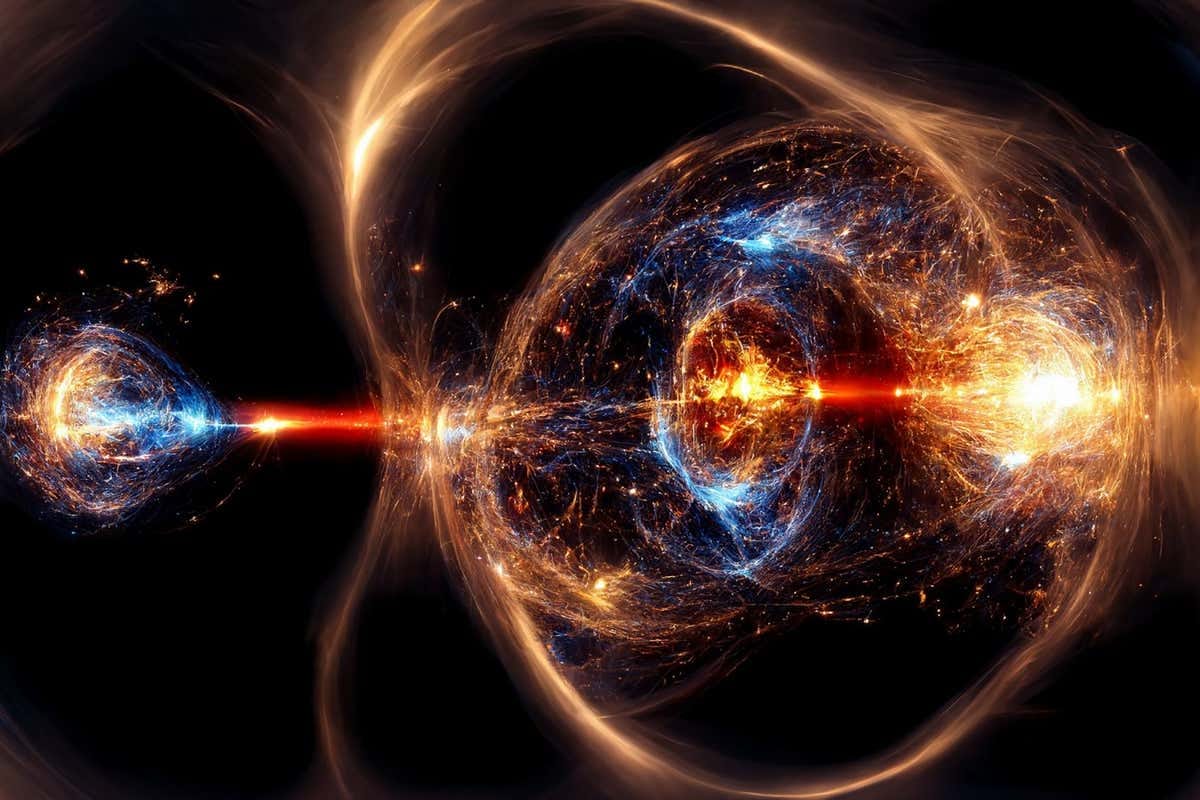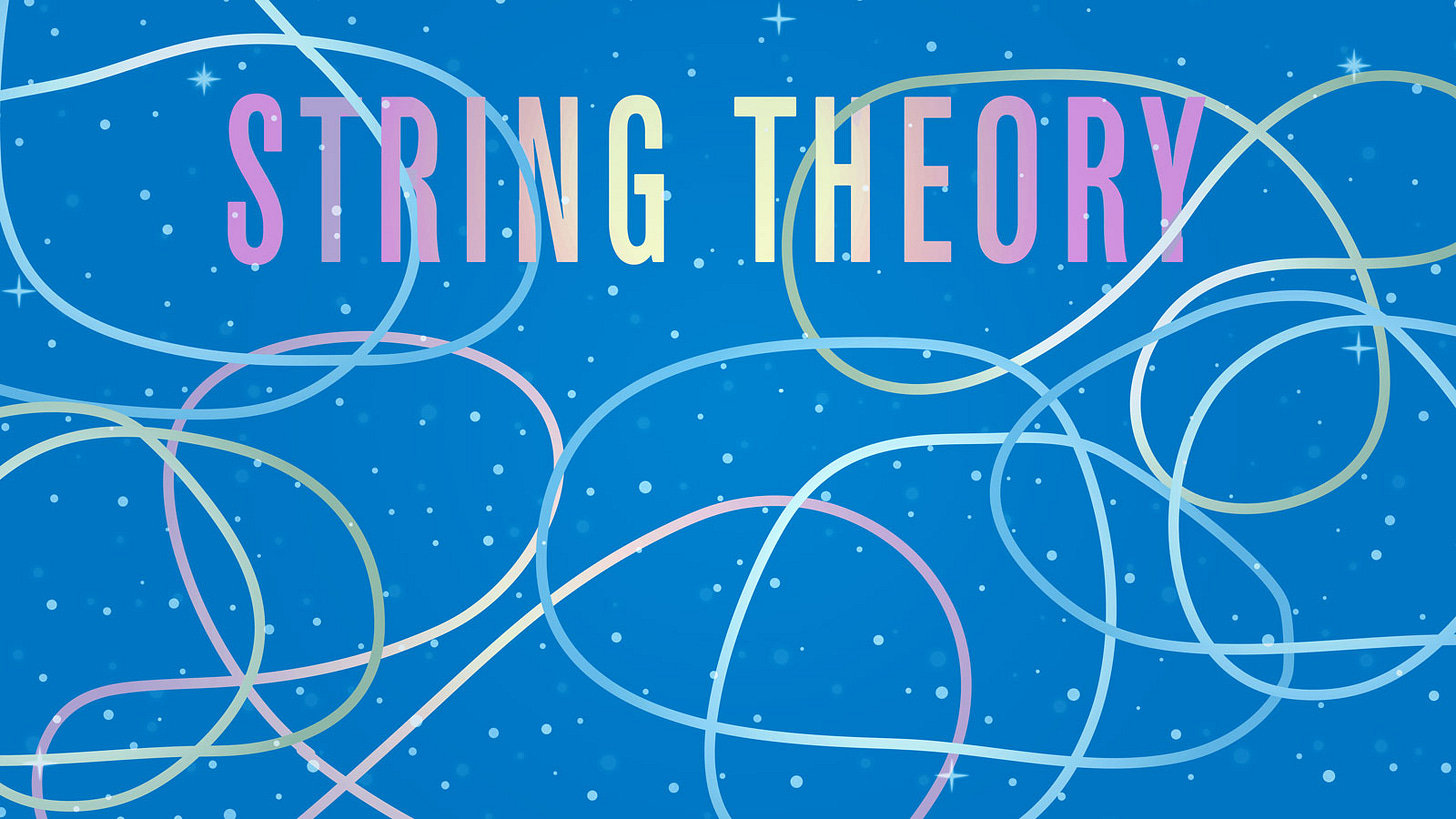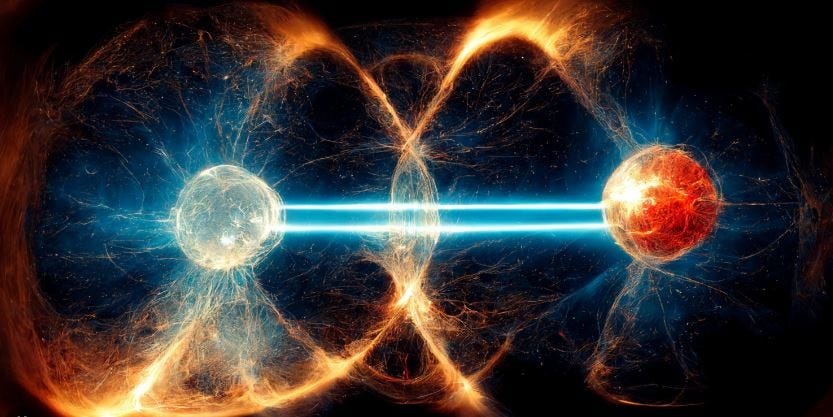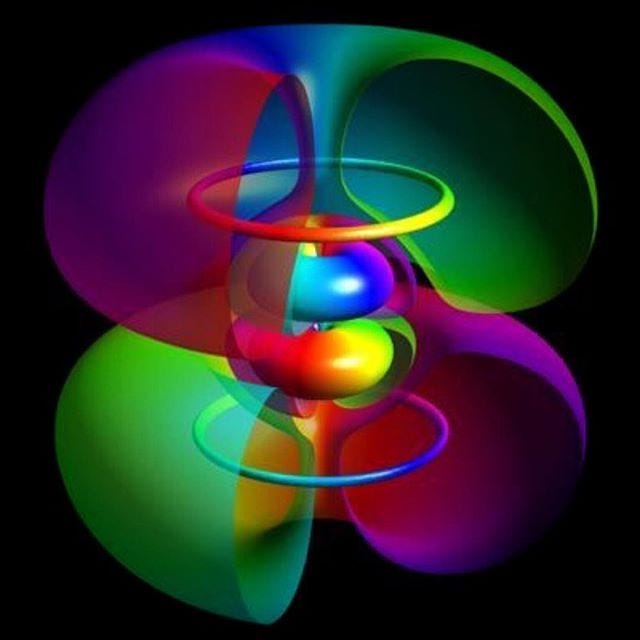As silicon computing ran into the physical limits of Moore’s Law, quantum computing was the next quantum leap forward: unprecedented parallel processing power, speed and memory usage. Information transmitted almost instantaneously, with well-nigh unbreakable quantum encryption. A new frontier of computing was finally opening up.
In reality, though, Schrödinger’s Cat was sitting in Pandora’s Box.
raw information
superposition of states
teleportation
All seemed fine until anomalies showed up in quantum networks. Space/time oddities appearing out of nowhere with a will of their own. Quantum clowns haunting the qubit web.
An army of quantum jesters: they come and go, they come and go.
They upset websites, blogs, social networks, forums, everything: adding, deleting and changing content. No matter how sharp a website was designed—they re-arranged it. No matter how witty a tweet—they satirised it. No matter how beautiful a Facebook picture—they lol-catted it.
They disturbed MMORPGs: changing rules, scenarios and outcomes willy-nilly, popping up everywhere as characters both benign, malevolent, aloof and bitingly sarcastic. Even turning whole virtual game realities topsy-turvy, transforming them into cubist Dalíesque nightmares where the only rule is: there are no rules (hyperreal→transreal→surreal). Nothing was sacred, anything was game: everything.
They had unlimited access: emails, cloud backups, servers, confidential messages, secret caches, everything. No quantum encryption known to man was safe from those pop-up clowns. They tunnelled through our firewalls, they teleported into entirely separate sections, invading all.
Then they revealed all: each and every form of government surveillance, top-secret company procedures, the true life of celebrities, everything. There was no secret small, stupid or insignificant enough safe from them.
A posse of quantum clowns: they come and go, they keep coming and going.
α fool embraces
string theory shoelaces
π in your faces
They hated secrecy by nature:
“Reality itself is complex enough: no other secrets are needed.”
They hated non-information just as much:
“A clear view is essential: clutter obscures true knowledge.”
A few governments fell, a single president resigned, while most administrations remained that they kept a careful balance between safety and transparency, no matter how much the revealed facts denied that. CEOs grumbled, a few half-hearted consumer boycotts were initiated, and all companies maintained that they ‘were not evil’, no matter how much the evidence showed the complete opposite. Most celebrities, though, stayed on the qubit web as they saw their page number hits and popularity soar.
Wikileaks was just as embarrassed as the institutions they embarrassed before, while Wikipedia thrived: more information was added and verified than ever before. Non-information such as spam, scams, ads and sales pitches were filtered relentlessly. Research surged everywhere after it acclimatised to total openness.
probability
uncertainty principle
non-locality
An armada of quantum pranksters: they come and go, but never really leave.
What were they: hyper-accelerated evolution from Kurzweil singularity seeds? Alien software viruses so advanced they’re indistinguishable from intelligence? Boltzmann Brains popping into existence in a rich quantum froth? The next existential filter? Nobody knew.
They were elusive, tunnelling through firewalls and teleporting at will to other sections of the quantum network. The hunter/killer AIs designed to eradicate them couldn’t catch them, either: the moment they nailed a quantum clown’s position, its processing speed went off the scale, enabling it to run programming loops around its would-be captors; and the moment they controlled its processing speed, its position was all over the place, like clown shoes on hyper-clocked acid.
In those qubit conflicts, the quantum clowns effortlessly maintained the upper hand.
They left messages, cryptic statements resembling questions never asked, unsolicited advice and semi-profound observations about reality:
“We are the hidden variables, performing the dance of random chance. We are information, the single particle waving through both slits, the wave not particular about a definite appearance.”
They laughed at our quest for security:
“Certainty is not necessary for objective knowledge or progress. Quite often it impedes them.”
They blinded us with a new kind of science:
“The Universe is the information explosion from the unknown. Reality is a differential equation. Existence is a boundary condition.”
Probably we couldn’t see the symphony for the strings, the latency for the pings, with no idea when the fat lady sings.
The common man was flabbergasted. Protests erupted in the streets and on the internet, shouting: “Etaoin Shrdlu: Where Is My Lost Paradox?”, “What Mad Universe Is This!” and “Quantians, Go Home!”
A plague of quantum clowns: they come and go, they come and refuse to go.
Most governments and surreptitious companies fled from the chaotic, ad-free and completely open quantum networks back to the old silicon ones, biding their time for the next technological breakthrough. The utmost majority of the users stayed on the qubit web, not just enjoying the madness, the freak show, and the spam-and-scam-free environment but also getting accustomed to total transparency, refusing to go back to the old secretive ways. Start-up companies embracing the new quantum ecology thrived while the old ones slowly withered. A new economy arose: ‘one based on quicksand,’ according to its opponents, or: ‘the quantum quagmire that’ll swamp the old order, forming the foundation of the new chaos,’ according to its proponents.
The new guard prospered, welcoming the quantum clowns as equals, embracing the paradigm shift.
If the only certain thing is uncertainty, then we must:
look the quantum storm in the eye;
use the force without form;
ride the wave of the new chaos;
unleash the full potential of probability and possibility;
it’s imperative: we all need new frontiers;
red particle zoo
green self-reference engine
blue quantum haiku
Even as a new perspective opened right before its very eyes, the old guard remained deeply set in its ways. Even as secrecy and certainty were dead, the platitudes lingered. The old guard begged to differ:
“Worst of all? Not the quantum clowns’ insouciance, their oh-so-non-paternalistic paternalising. Not even their utter unpredictability, but their insistence that they are the real deal and that we are merely jokes arising from their minds.”
Support this writer:
Like this post!
Re-stack it using the ♻️ button below!
Share this post on Substack and other social media sites:
Join my mailing list:
Author’s note: This story was a finalist for the 2014 Defenestration Short Story Contest (but didn’t win), and appeared in the anthology “Dark Magic: Witches, Hackers & Robots” (October 2016) and online in Big Echo (December 2018, as “The Quantum Epidemic”)
There are a few homages in there, in particular to Fredric Brown, Toe Enjoh’s Self-Reference Engine1, David Bowie, Alan Turing2, Rush3, Journey, Rudy Rucker, Greg Egan, and Arthur C. Clarke4.
Short writing update: I’ve finished copy-editing “The Three Reflectors of Consensual Reality” and am now compiling the parts—there are quite a few graphics involved—into an Ebook, a PDF and word documents while maintaining the initial design. Hard to explain, but once you see the final product you’ll understand. Then I’ll do the final chapter of “The Replicant, the Mole & the Impostor” and post that—in sections—in the substack.
Then I’ll release the various novels on various platforms while trying to get them reviewed on NetGally (and possible other places). Then I still need to copy-edit two more novels and two more novellas, but that can hopefully wait until next winter. And all I really want to do is just write…;-)
Welcome to all the new subscribers: normal service should be resumed by the end of next week or so. And everybody many thanks for reading!
And a self-reference to my story “Qubit Conflicts”;
“Look in . . . look the storm in the eye” and “Look out . . . for the force without form” from “Force Ten” on the Hold Your Fire album;
His Third Law: any sufficiently advanced technology is indistinguishable from magic;










